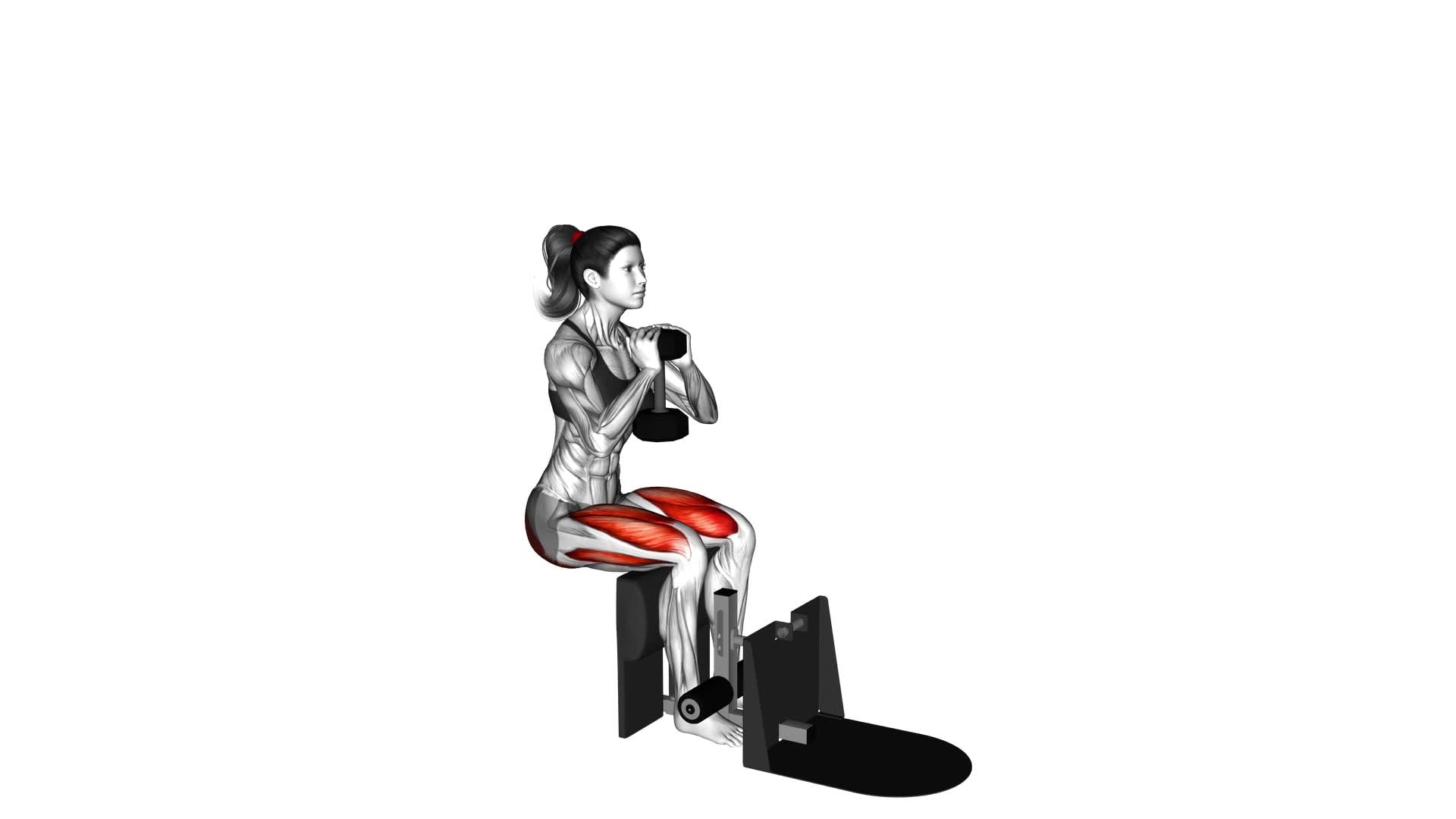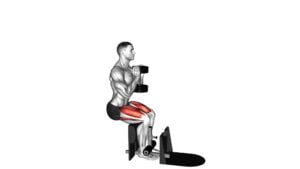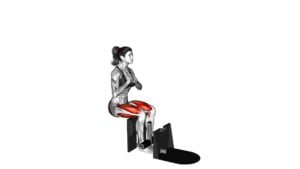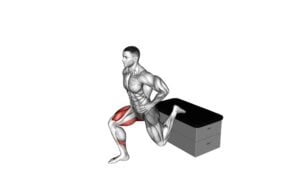Dumbbell Supported Squat (female) – Video Exercise Guide & Tips

Looking to amp up your leg day routine? Check out our video exercise guide and tips for the dumbbell supported squat.
Watch This Exercise Video
This variation of the squat targets your lower body muscles while providing additional stability and support.
Learn the proper form and technique, discover challenging variations, and get expert tips to maximize your results and avoid common mistakes.
Incorporate the dumbbell supported squat into your workout routine for stronger, toned legs.
Let's get squatting!
Key Takeaways
- Dumbbell supported squat improves balance and increases lower body strength.
- Engaging core muscles reduces the risk of falls and injuries.
- Proper form and technique are crucial to maximize benefits and reduce injury risk.
- There are various squat variations to challenge different muscle groups and gradually increase intensity.
Benefits of the Dumbbell Supported Squat
You can experience various benefits from incorporating the dumbbell supported squat into your workout routine. This exercise is highly effective in improving balance and increasing lower body strength. By adding dumbbells as support, you engage your core muscles even more, enhancing stability and control during the movement.
Improving balance is crucial for everyday activities like walking, running, and even standing. The dumbbell supported squat challenges your balance by forcing you to maintain stability while performing the exercise. This helps to strengthen the muscles in your legs and core that are responsible for maintaining balance, ultimately reducing the risk of falls and injuries.
In addition to balance, the dumbbell supported squat is an excellent way to increase lower body strength. It targets your quadriceps, hamstrings, glutes, and calves, making it a highly effective exercise for developing strong and toned legs. By progressively increasing the weight of the dumbbells over time, you can continually challenge your muscles and stimulate growth.
Incorporating the dumbbell supported squat into your workout routine can yield significant benefits in terms of balance improvement and lower body strength increase. So, grab a pair of dumbbells and start reaping the rewards of this powerful exercise.
Proper Form and Technique for the Exercise
To perform the dumbbell supported squat correctly, it's important to focus on maintaining proper form and technique throughout the exercise. This won't only maximize the benefits of the workout but also reduce the risk of injury.
One common mistake is allowing your knees to go past your toes as you lower yourself into the squat. To avoid this, make sure to push your hips back and keep your knees in line with your toes.
Another mistake is arching your back or rounding your shoulders. Instead, keep your chest up and your spine neutral throughout the movement.
It's also important to maintain a stable core by engaging your abs and glutes. This will help you maintain balance and control.
Lastly, be mindful of your foot placement. Keep your feet shoulder-width apart and firmly planted on the ground.
Following these proper form and technique guidelines will ensure an effective and safe dumbbell supported squat workout routine.
Variations to Challenge Your Lower Body
To challenge your lower body, try incorporating different variations of the dumbbell supported squat. By using different equipment and advanced modifications, you can take your lower body workout to the next level.
One variation you can try is the goblet squat. Instead of holding dumbbells at your sides, hold a single dumbbell in front of your chest with both hands. This variation not only challenges your lower body but also engages your core muscles.
Another variation is the Bulgarian split squat. This exercise requires a step or bench behind you. Place one foot on the step and lower your body down into a squat position. This variation targets your quads, glutes, and hamstrings.
If you're looking for an even greater challenge, try the pistol squat. This advanced modification requires you to balance on one leg while lowering your body down into a squat position. It requires a great deal of strength, stability, and flexibility.
Incorporating these variations into your lower body workout routine will help target different muscle groups and keep your workouts interesting and challenging. Remember to start with lighter weights and gradually increase the intensity as you get stronger and more comfortable with the exercises.
Tips for Maximizing Results and Avoiding Common Mistakes
To maximize your results and avoid common mistakes, incorporate these tips into your dumbbell supported squat routine.
First, focus on maximizing intensity by using challenging weights. Start with a weight that allows you to complete 8-12 reps with proper form, and gradually increase the weight as you get stronger. This will ensure that your muscles are constantly being challenged and stimulated for growth.
Next, pay attention to your form to avoid injuries. Keep your chest up, back straight, and knees aligned with your toes throughout the movement. Avoid rounding your back or allowing your knees to cave inwards, as this can put unnecessary stress on your joints.
Additionally, make sure to warm up properly before performing dumbbell supported squats. A dynamic warm-up that includes exercises like leg swings and hip circles will help increase blood flow to your muscles, improve your range of motion, and reduce the risk of injury.
Finally, listen to your body and take rest days when needed. Overtraining can lead to injuries and hinder your progress. Aim for at least one day of rest between each squat workout to allow your muscles to recover and grow.
Incorporating the Dumbbell Supported Squat Into Your Workout Routine
To incorporate the dumbbell supported squat into your workout routine, focus on gradually increasing the weight and maintaining proper form to challenge your muscles and prevent injury.
Here are three tips to help you maximize your results and avoid common mistakes:
- Start with lighter weights: If you're new to the dumbbell supported squat, begin with light weights to allow your body to adapt to the movement. As you become more comfortable and confident, gradually increase the weight to continue challenging your muscles.
- Focus on proper form: Proper form is crucial for maximizing results and preventing injury. Keep your back straight, chest lifted, and feet shoulder-width apart. As you squat, lower your hips until your thighs are parallel to the ground and then push through your heels to return to the starting position.
- Add variety: To keep your workouts interesting and prevent plateaus, consider incorporating variations of the dumbbell supported squat. You can try sumo squats, goblet squats, or single-leg squats to target different muscle groups and keep your routine fresh.
Frequently Asked Questions
How Much Weight Should I Use for the Dumbbell Supported Squat?
To determine how much weight to use for the dumbbell supported squat, start with a weight that challenges you but allows you to maintain proper form. Gradually increase the weight as you become stronger and more comfortable with the exercise.
Remember to engage your core, keep your back straight, and lower yourself down until your thighs are parallel to the ground.
Adding the dumbbell supported squat to your workout routine can help strengthen your legs, glutes, and core muscles.
Can I Perform the Dumbbell Supported Squat Without Using Dumbbells?
Yes, you can perform the dumbbell supported squat without using dumbbells. There are alternative exercises you can do, such as bodyweight squats or using a stability ball against a wall.
However, using dumbbells in the squat has its benefits. It adds resistance to the movement, helping to increase muscle strength and improve overall stability. Incorporating dumbbells can also challenge your core and enhance the effectiveness of the exercise.
Is the Dumbbell Supported Squat Suitable for Beginners?
The dumbbell supported squat is a great exercise for beginners. It helps build strength in your lower body and improves your overall stability. While using dumbbells is recommended for added resistance, there are variations of the exercise that can be done without them.
The benefits of the dumbbell supported squat include increased muscle endurance, improved balance, and enhanced functionality in daily activities. It's a beginner-friendly exercise that can be modified to suit your fitness level.
Can I Do the Dumbbell Supported Squat if I Have Knee or Back Problems?
If you have knee or back problems, the dumbbell supported squat may not be suitable for you. It's important to prioritize your safety and avoid exercises that could exacerbate your condition.
Instead, focus on modifications that can provide similar benefits without putting unnecessary strain on your knees or back. Consult with a professional trainer or physical therapist who can suggest alternative exercises tailored to your specific needs.
How Often Should I Incorporate the Dumbbell Supported Squat Into My Workout Routine for Optimal Results?
To incorporate the dumbbell supported squat into your workout routine for optimal results, aim to do it 2-3 times per week.
This exercise targets multiple muscle groups, making it a great addition to a full body workout routine.
You can also try different variations of the dumbbell supported squat, like using different weights or adding in a pulse at the bottom of the squat.
Remember to listen to your body and adjust as needed if you have knee or back problems.
Conclusion
Incorporating the dumbbell supported squat into your workout routine can provide numerous benefits for your lower body. By maintaining proper form and technique, you can effectively target your quadriceps, hamstrings, and glutes. Additionally, there are variations to challenge yourself and maximize results.
Remember to start with lighter weights and gradually increase as you build strength. Avoid common mistakes and consult with a fitness professional for personalized guidance.
Get ready to strengthen and tone your lower body with this effective exercise.

Author
Years ago, the spark of my life’s passion ignited in my mind the moment I stepped into the local gym for the first time. The inaugural bead of perspiration, the initial endeavor, the very first surge of endorphins, and a sense of pride that washed over me post-workout marked the beginning of my deep-seated interest in strength sports, fitness, and sports nutrition. This very curiosity blossomed rapidly into a profound fascination, propelling me to earn a Master’s degree in Physical Education from the Academy of Physical Education in Krakow, followed by a Sports Manager diploma from the Jagiellonian University. My journey of growth led me to gain more specialized qualifications, such as being a certified personal trainer with a focus on sports dietetics, a lifeguard, and an instructor for wellness and corrective gymnastics. Theoretical knowledge paired seamlessly with practical experience, reinforcing my belief that the transformation of individuals under my guidance was also a reflection of my personal growth. This belief holds true even today. Each day, I strive to push the boundaries and explore new realms. These realms gently elevate me to greater heights. The unique combination of passion for my field and the continuous quest for growth fuels my drive to break new ground.







